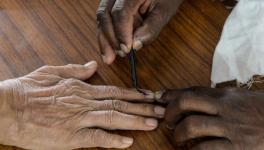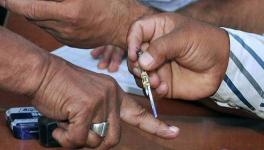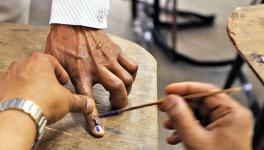How Kerala's Local Bodies Helped Fight COVID-19
With the Kerala Local Body Elections entering its final phase, the decentralisation experiment, implemented in 1996 by the then Left Democratic Front (LDF) Government, is being talked about once again. It was due to this process that powers, functions and funds have been devolved to local bodies in the state, making sure that calamities get an adequate response.
Starting from the first tier (panchayats), five sets of elected bodies – Panchayats, Block Panchayats, Municipalities, district Panchayats and Corporations – ensure the common man of access to the system.
The three-tier local government institutions are crucial; its efficiency and spontaneity were noted during recent natural calamities, be it the floods in 2018 and 2019 or the pandemic this year. Before decentralisation happened, the planning happened at the top, like in every other state.
The gram sabhas are the basic pillars of decentralisation in the State, with the bodies discussing almost every activity in a village constituency, which helps to prevent corruption and reduce control of the bureaucracy and politicians in the local bodies.
“The Kerala’s People campaign for Democratic Decentralisation constitutes a remarkable radical experiment in democracy. Initially called the People’s Campaign for the Ninth Plan, it has decentralised the functions of a government bureaucracy; it has decentralised planning while mobilising the energy of hundreds of thousands of activists and volunteers to go beyond what government-funded projects can accomplish,” said state Finance Minister Dr. Thomas Isaac and Richard W. Franke in their book titled ‘Local Democracy and Development: The Kerala People's Campaign for Decentralized Planning’.
The first major step of democratic decentralisation was conducting gram sabhas from August 17 to November 1996, in order to identify the needs of people and generate participation and interest in the campaign. Development seminars were then held from October 21 1996 to December, 1996, in north Kerala and in South Kerala. These seminars assessed their resources and listed ideas for eventual formal projects. A task force had formulated proposals development seminars into formal projects.
Following this, the village and municipal councils and block and district council meetings were held to finalise plans. Later, volunteer Technical Corpus expert committees were set up for appraisal and looking at technical corrections in projects. Funds were later released till June 30, 1998 for the implementation of projects. This was how the plan functioned in its first year.
As a result, local self-governments are no longer starved for funds now. The local self-governments have well-defined powers and responsibilities, crucial for the development of the society at the grass root level. The 50% representation for women and the Scheduled Castes and Scheduled Tribes in local self-governments have also been crucial.
During the first year of the new local bodies (1996-97), a total of Rs 212 crores had been provided to them “to initiate the preparation and implementation of local level need based plan programs for development”.
Aside from funds and powers, local self-governments have control over various government departments. The COVID-19 pandemic has shown how efficiently the state has been dealing the crisis. Along with the health department, representatives of local self-governments and self-help groups have been very active, right from contact-tracing to community kitchens.
During the national lockdown announced by Prime Minister Narendra Modi on March 24 this year, the Kerala government started community kitchens across the state. Community kitchens ensured food for all across the state during the lockdown, and were set up in every panchayat across the state. The gram panchayats had complete control of community kitchens and elected representatives from each panchayat had to ensure that no one starved.
Along with health care institutions, government schools up to the district level and other government institutions are also under the jurisdiction of the local self-governments. The panchayats have also been entrusted with ensuring basic services like housing, sanitation, drinking water facilities, rural roads etc.
S.M. Vijyanand, former Chief Secretary of Kerala and an expert in decentralised planning, in a recent conversation about Kerala’s unique model, noted: “Kerala historically has been known for what is called public action. People and government are close together. It started even during the Maharajas (time). Kerala is an organised society. Practically almost every person in Kerala would belong to some organization – not one organization. We can call it social capital. In this context, Kerala started the literacy campaign which had become a national model where we tried mobilising voluntary support going beyond politics and reaching out as a kind of social duty towards the illiterate and that became a good model. Unfortunately it hadn’t been picked up by the next government (sic).”
“In the mid 90s, big bang decentralization had been implemented. So the present efforts of the government should be seen in context of this kind of volunteerism which existed in the society which is mobilised by the government during literacy campaign, and then the people’s plan campaign which mobilised lots of people to do task for gram panchayat, block panchayats etc (sic).”
Speaking of the healthcare system, every gram panchayat in Kerala has a primary health centre. Taluk hospitals or community health centres are with the block panchayats/municipalities, the district hospitals are with the district panchayats; it means the primary and secondary health centres have been transferred to the local governments. The transfer means they work under the supervision of local governments while the state government pays their salaries. For maintenance functions, money goes to them through the panchayats. For development activities, between 50% and 60% of the money goes through panchayats. So, there is a working relationship between PHCs and panchayats.
Get the latest reports & analysis with people's perspective on Protests, movements & deep analytical videos, discussions of the current affairs in your Telegram app. Subscribe to NewsClick's Telegram channel & get Real-Time updates on stories, as they get published on our website.

















